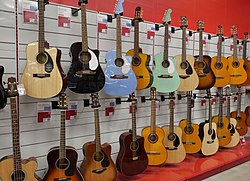Acoustic guitar
Acoustic guitars[1] are hollow-bodied string instruments that believe resonance to supply sound. Once you pluck a string or strum a chord, the vibration of the strings is amplified by the highest of the guitar and thru the soundhole. These marks show where to press a string with the fingers of the left hand, to change the note that string plays. The right hand plucks or strums the strings, either with the fingers or using a plectrum ("pick"), to make them sound. Acoustic guitars are used in types of music ranging from classical to rock and roll, to bluegrass and folk. The six strings can be steel or nylon. Nylon strings are typically used for classical and related styles of music. Steel strings are typically used for most other styles.
 A selection of acoustic guitars in store, including steel-strings and classical type instruments | |
| String instrument | |
|---|---|
| Classification | String instrument (plucked, nylon stringed guitars usually played with fingerpicking, and steel-, etc. usually with a pick.) |
| Hornbostel–Sachs classification | 321.322 (Composite chordophone) |
| Developed | 13th century[source?] |
| Playing range | |
 (a regularly tuned guitar) | |
| Related instruments | |
| Bowed and plucked strings instruments | |


How the guitar became a popular instrument
changeThe acoustic guitar came from Spain (an instrument with six strings), created by Antonio Torres Jurado.[2] But at the beginning, the guitar was different with what we see the guitar now. In the 16th to 17th centuries, the guitar became popular in Europe. In the 18th century, the guitar changed to be similar to how it is now. But before the 19th century, many people thought the guitar could not be same as a piano or violin. They thought it could not play classical music. But at the beginning of 19th century, a famous guitar player, Fernando Sor, made the guitar become more popular and he made more people like playing the guitar.[2] Before the 20th century, people played the acoustic guitar. In the 20th century, a musician in United States, Leo Fender, invented the electric guitar.
Guitar and ukulele compared
changeThe guitar and the ukulele are similar in shape and other ways, but they are also different. The ukulele looking like a small guitar. But the guitar has six strings, and the ukulele has just four strings. The six strings in a guitar are tuned: E, B, G, D, A, and E;[3] the four strings in a ukulele are tuned: G, C, E, and A. Also, the ukulele comes from Hawaii, and the guitar comes from Spain.[4]
Other websites
changeMedia related to Acoustic guitars at Wikimedia Commons
References
change- ↑ com, proaudiostar. "Acoustic Guitars". proaudiostar.com. Archived from the original on 2022-12-14.
- ↑ 2.0 2.1 Chabot, Paul. "A history of the guitar". Guitar site. Guitar site. Retrieved 23 May 2017.
- ↑ Powers, Wendy (September 2007). "The Guitar". The Met. The Met. Retrieved 23 May 2017.
- ↑ "Ukulele". The Met. The Met. Retrieved 23 May 2017.